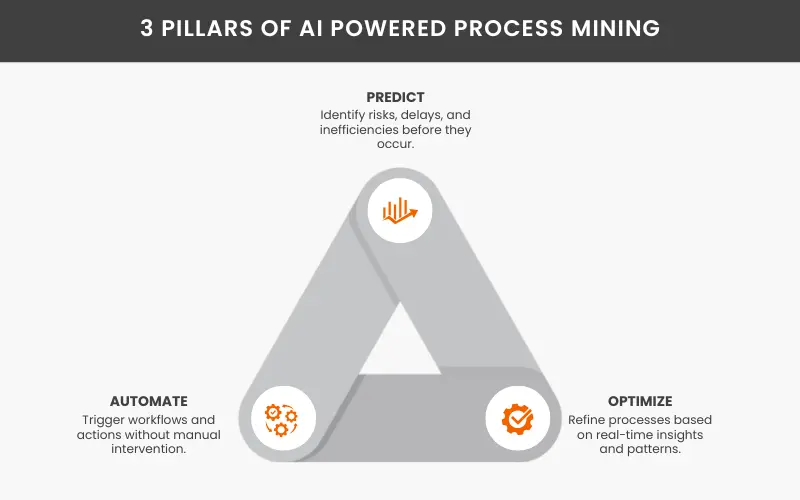Have you ever wondered if your business can handle problems and get better without your constant direction? Thanks to artificial intelligence, this is now possible. AI is changing many areas in business, such as providing better customer service, catching fraud instantly and forecasting issues in supply chains. Currently, this same technology is transforming process mining. Traditional process mining tells you what key events occurred in your workflows, whereas AI-based process mining catches risks before they appear and handles them automatically. Let’s look at how AI is changing process mining and what impact it has on your business.
What is AI-Powered Process Mining?
Consider traditional process mining as a detective, it reviews your information, finds repeatable actions and lets you know the order of events. AI process mining makes things more advanced, acting just like a detective, a fortune teller and a personal assistant.
Whereas standard process mining shows what happened in the past, AI process mining predicts new problems, notices patterns and is capable of fixing processes automatically. It goes beyond examining; it boosts your processes.
The process of process mining incorporates AI.
- Machine learning software to notice patterns that people don’t spot.
- Deep learning for extremely fast processing of data.
- NLP is used to make sense of data that is not organized.
- Forecasting potential problems using predictive analytics.
With this approach, AI helps your analysts by dealing with the heavy data lifting, which allows them to focus on more important tasks.
Predictive Analytics: Your Crystal Ball for Business Processes
Preventing equipment failures is now easier because of new technologies. By using process mining AI, you can identify problems in advance, which every business leader aims for.
It works as an alert mechanism, looking at history to foresee when problems like holdups, delays or quality issues could arise. As an example, AI can show that during loan approval, certain factors or days play a role in producing longer wait times or more requests that are rejected. These predictions rely on data and have confidence ratings, which improve the system’s intelligence as time goes by.
Because of this, you can:
- Make preparations and use resources before the peak season arrives.
- Carry out regular maintenance so that your equipment doesn’t stop operating.
- Update your work process before problems slow everything down.
- Do your best to stop issues with compliance before they start.
Using business intelligence is similar to using a GPS that alerts you to issues ahead of time.
Intelligent Automation: When AI Takes the Wheel
Traditional process mining gives you ideas, but it’s up to you to change the system. AI process mining addresses this issue by handling actions itself after examining the information. Suppose the AI spots that there might be a delay in delivery; it will immediately move tasks to other teams, give resources to different projects and let customers know about the issue, all automatically.
AI helps keep processes up-to-date by checking different methods, measuring their consequences and transferring the top changes to all areas of the company.
This is what the process looks like when applied:
- AI continuously checks the process for differences and immediately changes the procedure.
- Predictions of future demand are used to automatically reassign current workloads.
- When AI encounters different cases, it updates its responses and becomes better.
- When problems are identified, stakeholders are notified right away.
Continuous Improvement: AI That Never Stops Learning
AI in process mining is particularly unique because it keeps getting better with time. Unlike ordinary systems that must be changed manually, AI keeps itself updated based on what it learns and the shifts in business requirements. It is similar to having a constant presence of a process expert, who learns new things all the time and quickly spots patterns and makes improvements.
As a result, a good cycle is created.
- Having good data helps us make better decisions.
- Sharper insights help improve the way we work.
- The use of improved processes creates better data.
- With each cycle, the system gets better step by step
Continuous learning helps a lot when dealing with unusual and unexpected situations. Rather than just detecting unusual activity, AI can also adjust your systems to become more adaptable and complex as time passes. When industries move quickly, your procedures can adapt easily to market demands, laws or the newest technologies, so your AI will grow in importance.
Implementation Challenges and How to Overcome Them
We all know that getting started with AI process mining isn’t always as easy as it seems. Knowing about the challenges helps you be ready for them.
- Data Quality Issues: The quality of AI depends on the quality of its data. If the data is not good, the automation decisions will be incorrect, and insights may not be accurate.
Solution: Sort out data governance and quality assurance issues before starting to use AI. Good results start with clean and standardized data. - Integration Complexity: Most companies use legacy systems that haven’t been made for integrating AI. It may lead to technical issues and call for a large investment in infrastructure.
Solution: Start the process step by step. First, try using AI process mining in one place and understand what happens and then increase its use step by step. - Change Management: Many employees can be resistant to AI, since they may worry about losing their jobs.
Solution: Ensure you focus on sharing information and ensuring everyone is properly trained. Introduce AI to your team by saying that it improves their strengths, not by replacing their duties. Allow them to take an active part in carrying out the actions.
The Future of AI in Process Mining
Where is process mining AI heading? The future is bright and full of possibilities:
- Self-Optimizing Organizations: Soon, AI will allow companies to control, examine and optimize their workflows automatically, without much help from people.
- Quantum Computing: When quantum technology develops, AI’s capabilities to analyze and improve complex processes will increase.
- Edge Computing: With Edge Computing, process mining can take place anywhere and instantly improve operations, no matter the location.
- Natural Language Processing: By using Conversational AI, you can easily find and act on important information just by asking questions.
- IoT Integration: AI-based process mining used together with IoT technology can provide businesses with real-time monitoring of all operations.
While some organizations may face challenges because of the technology involved and the initial expenses, using experts or starting slowly with pilot projects can help solve these issues and use all the benefits AI has to offer in process mining
Conclusion
AI works seamlessly with process mining, and this makes a major impact on how businesses operate. Businesses that introduce AI process mining to their workflows currently will operate successfully and adapt fast to shifting circumstances.
The key concern is whether you can speedily introduce these technologies to transform how you operate. These are the steps you can follow to begin.
- Consider which process mining tools you have and how well you are able to use them.
- Find places where AI can produce the most results.
- Carry out a pilot project to show the value of your approach.
- Pay attention to ensuring the data is reliable and of high quality.
- Ensure your team gets ready for change.
AI is leading a new revolution in modern business. Should you take charge or trust others to be in charge? Anyone who has mastered predicting, optimizing and automating with AI will be successful in the future. You can begin learning better and updating the way you work today.




